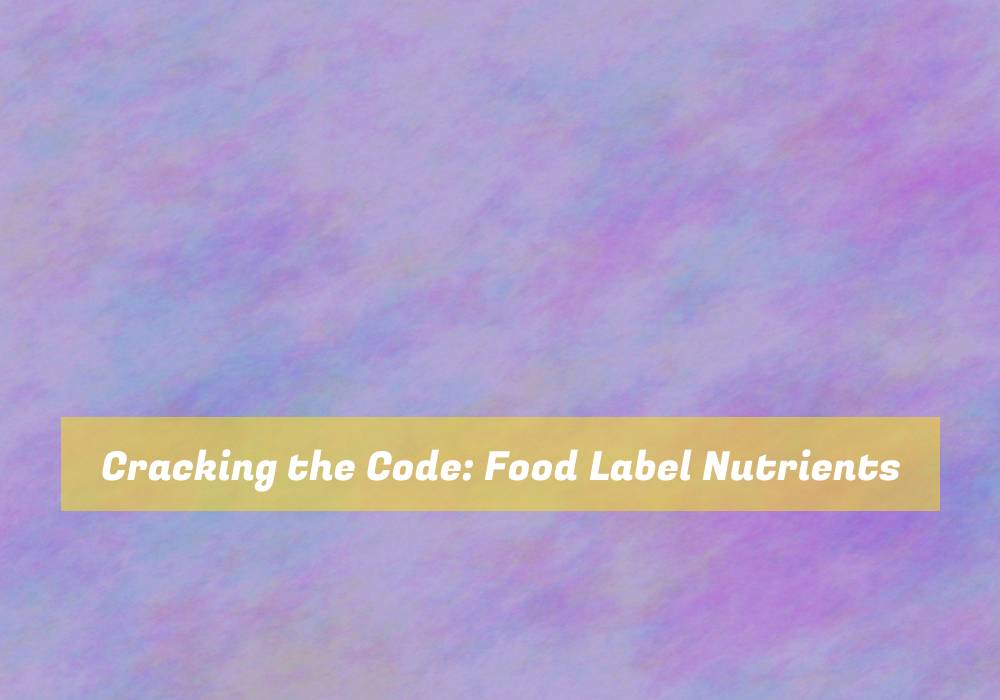Cracking the Code: Food Label Nutrients
Are you really getting all the nutrients you need from the food you eat? Understanding the information on food labels can be the key to making informed choices about what you put into your body.
From serving sizes to decoding the % Daily Value, thereG??s a lot to take in when it comes to understanding food label nutrients.
But fear not, because with a few simple tips and tricks, you can crack the code and make healthier choices for yourself and your family.
Understanding Serving Sizes
Understanding serving sizes is crucial for making informed decisions about your food intake. When you pick up a food product and glance at the nutrition label, the serving size is the first thing you should check. This information tells you the amount of food the nutrition facts are based on.
ItG??s important to note that the serving size listed on the label may not be the portion you actually consume in one sitting. Many people unknowingly eat larger portions than the standard serving size, which can lead to consuming more calories, fat, and other nutrients than they realize.
By understanding serving sizes, you can better manage your calorie and nutrient intake, helping you maintain a balanced diet. Pay attention to the number of servings per container as well, as some products may appear to be a single serving but actually contain multiple servings.
Being aware of serving sizes empowers you to make healthier choices and control your food portions more effectively.
Key Nutrients to Look For
When checking the nutrition label, be sure to focus on key nutrients to make informed decisions about your food intake.
The first nutrient to look for is fiber, as it aids in digestion and helps you feel full, making it an important component of a balanced diet.
Next, pay attention to the amount of protein listed. Protein is crucial for muscle repair and growth, as well as for maintaining a healthy immune system.
Additionally, keep an eye on the levels of essential vitamins and minerals such as vitamin D, calcium, iron, and potassium. These nutrients play vital roles in bone health, energy production, and overall bodily functions.
Monitoring the sugar content is also crucial, as excessive sugar intake can lead to various health issues.
Finally, donG??t forget to check the type and amount of fats present. Opt for foods with healthy fats like omega-3 fatty acids and unsaturated fats, while limiting the intake of saturated and trans fats.
Decoding % Daily Value
Deciphering the % Daily Value on food labels empowers you to gauge the nutritional significance of the product in relation to your daily dietary needs. The % Daily Value is based on a 2,000-calorie diet, so if you consume more or less than 2,000 calories a day, your individual needs may vary. This percentage helps you understand how much a serving of the food contributes to your daily intake of specific nutrients. For instance, if a food item has 20% of the Daily Value for fiber, it means that one serving provides 20% of the fiber you need for the day based on a 2,000-calorie diet.
When examining the % Daily Value, remember that 5% or less is considered low, while 20% or more is high. Aim to select foods with higher % Daily Values for nutrients like fiber, vitamin D, calcium, iron, and potassium, as these are often lacking in the average diet.
Conversely, try to limit foods with higher % Daily Values of saturated fat, sodium, and added sugars, as excessive intake of these can have negative health effects. Understanding the % Daily Value is a crucial aspect of making informed and healthier food choices.
Navigating Ingredient Lists
To better understand the nutritional value of the foods you consume, itG??s essential to navigate ingredient lists on food labels effectively. When reading ingredient lists, focus on the first few ingredients as they make up the largest portion of the food. Look for whole foods such as fruits, vegetables, whole grains, and lean proteins at the beginning of the list. Be cautious of items like sugar, hydrogenated oils, and high-fructose corn syrup, which are often listed near the top and should be consumed in moderation.
Additionally, be aware of different names for sugars, such as sucrose, high fructose corn syrup, and dextrose. Understanding these aliases can help you identify added sugars more easily. Keep an eye out for artificial additives and preservatives, indicated by complex names that are difficult to pronounce.
ItG??s also important to consider the placement of allergens if you have sensitivities or allergies. Manufacturers are required to highlight common allergens like peanuts, soy, dairy, and wheat in the ingredient list or with a separate allergen statement.
Conclusion
Now that you understand how to crack the code on food labels, you can make informed decisions about the nutrition in the foods you eat.
Pay attention to serving sizes, key nutrients, % Daily Value, and ingredient lists to ensure youG??re getting the most out of the foods you consume.
By using this knowledge, you can take control of your diet and make healthier choices for yourself and your family.






